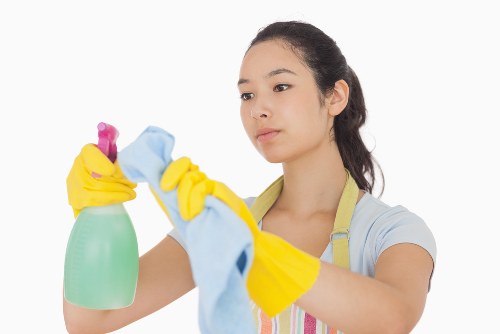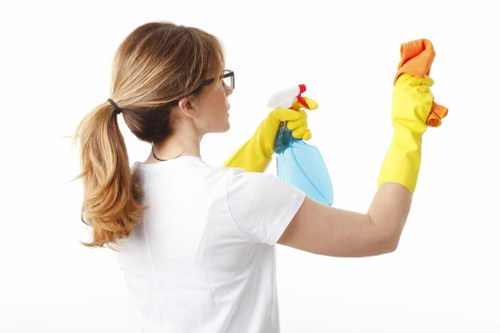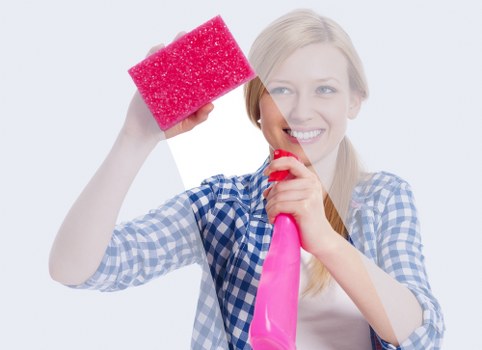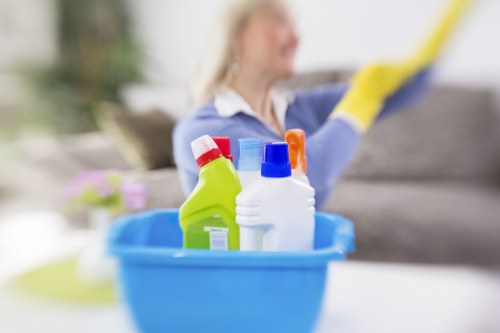Upholstery Cleaning in Spot Cleaner: Achieve Pristine Furniture Effortlessly

Maintaining the cleanliness of your upholstery is essential not only for aesthetic appeal but also for the longevity of your furniture. **Upholstery cleaning** plays a crucial role in preserving the fabric, preventing wear and tear, and ensuring a healthy living environment. Among the various tools available, a spot cleaner stands out as an effective solution for tackling stubborn stains and spills.
Spot cleaners are designed to target specific areas, making them ideal for immediate response to accidents or regular maintenance cleaning. Whether it's a spilled glass of wine, pet accidents, or everyday dirt and grime, a spot cleaner can handle a wide range of challenges.
In this comprehensive guide, we will delve into the benefits of using a spot cleaner for upholstery, provide step-by-step cleaning instructions, and offer tips to maintain your furniture's pristine condition.

Why Choose Spot Cleaners for Upholstery?
Spot cleaners are versatile devices that offer several advantages over traditional cleaning methods. Here are some compelling reasons to opt for a spot cleaner for your upholstery needs:
- Efficiency: Spot cleaners deliver concentrated cleaning power directly to the affected area, ensuring rapid and effective stain removal.
- Convenience: These devices are portable and easy to use, eliminating the need for professional cleaning services in many cases.
- Cost-Effective: Investing in a spot cleaner can save you money in the long run by reducing the frequency of salon visits and extending the life of your furniture.
- Eco-Friendly: Many spot cleaners use minimal water and eco-friendly cleaning solutions, making them a sustainable choice for environmentally conscious households.
With these benefits, it's clear why spot cleaners are becoming the go-to solution for homeowners seeking practical and effective upholstery cleaning methods.

Understanding the Spot Cleaning Process
The process of spot cleaning upholstery with a spot cleaner involves several key steps to ensure optimal results. Here's a breakdown of the typical procedure:
- Identify the Stain: Determine the type of stain and the fabric you're dealing with, as this will influence the cleaning approach and products used.
- Prepare the Spot Cleaner: Fill the device with the appropriate cleaning solution. For natural stains, water may suffice, but for tougher stains, specialized upholstery cleaners are recommended.
- Test the Cleaner: Before applying the cleaner to a visible area, perform a patch test in an inconspicuous spot to ensure it doesn't cause discoloration or damage.
- Apply the Cleaner: Use the spot cleaner as per the manufacturer's instructions, focusing on the stained area. Gently work the cleaner into the fabric to break down the stain.
- Blot and Dry: After cleaning, blot the area with a clean cloth to absorb excess moisture. Allow the upholstery to air dry completely to prevent mold and mildew growth.
Following these steps carefully will help you achieve the best possible cleaning outcome, preserving the beauty and integrity of your upholstery.

Choosing the Right Spot Cleaner for Your Needs
When selecting a spot cleaner for upholstery, it's important to consider various factors to ensure you choose the best model for your specific needs. Here are some key aspects to evaluate:
- Power and Suction: A powerful motor and strong suction capability are essential for effective stain removal and moisture extraction.
- Attachments and Accessories: Look for spot cleaners that come with a variety of attachments, such as upholstery tools, crevice nozzles, and brush heads, to tackle different types of stains and fabric textures.
- Ease of Use: Choose a lightweight and ergonomically designed spot cleaner that is easy to maneuver around furniture and confined spaces.
- Water Capacity: A larger water tank allows for more extensive cleaning sessions without the need for frequent refills.
- Portability: If you plan to use the spot cleaner in multiple rooms or take it on the go, opt for a portable and compact model.
By considering these factors, you can select a spot cleaner that not only meets but exceeds your upholstery cleaning expectations.

Top Tips for Effective Upholstery Spot Cleaning
Maximize the efficiency of your spot cleaning efforts with these expert tips:
- Act Quickly: Address spills and stains as soon as they occur to prevent them from setting into the fabric.
- Blot, Don’t Rub: Gently blot the stain to absorb the spill without spreading it further or damaging the fabric fibers.
- Use Appropriate Cleaners: Ensure you're using cleaners that are suitable for your specific upholstery material to avoid discoloration or damage.
- Regular Maintenance: Incorporate spot cleaning into your regular cleaning routine to maintain your upholstery's appearance and hygiene.
- Follow Manufacturer’s Instructions: Always adhere to the guidelines provided by the spot cleaner's manufacturer for optimal performance and safety.
Implementing these tips will help you achieve lasting results and keep your upholstery looking fresh and new.

Common Upholstery Stains and How to Remove Them
Different stains require different cleaning approaches. Below are some of the most common upholstery stains and effective methods to remove them using a spot cleaner:
1. Coffee and Tea Stains
Mix a solution of equal parts water and white vinegar. Apply the mixture to the stain, gently scrub with a soft brush, and blot with a clean cloth until the stain lifts.
2. Grease and Oil Stains
Sprinkle baking soda on the stain and let it sit for 15 minutes to absorb the oil. Vacuum the baking soda, then apply a degreasing upholstery cleaner and blot until the stain disappears.
3. Ink Stains
Use rubbing alcohol or an alcohol-based cleaner. Apply a small amount to the stain, dab gently with a cloth, and repeat until the ink fades.
4. Pet Stains
Enzyme-based cleaners are most effective for pet stains. Apply the cleaner, allow it to sit for the recommended time, and then blot it up with a clean towel.
5. Red Wine Stains
Absorb excess wine with a cloth, apply a mixture of water and dish soap, blot the area, and repeat until the stain is gone.

Maintaining Upholstery After Spot Cleaning
Proper maintenance after spot cleaning is key to extending the life of your upholstery. Here are some strategies to keep your furniture in top condition:
- Regular Vacuuming: Remove dust and debris by vacuuming your upholstery regularly to prevent particles from embedding into the fabric.
- Use Protective Covers: Consider using slipcovers or throws to protect your furniture from spills and stains.
- Avoid Direct Sunlight: Protect your upholstery from fading by keeping it out of prolonged direct sunlight.
- Rotate Cushions: Regularly rotate and flip cushions to ensure even wear and prevent sagging.
- Address Spills Immediately: Promptly attending to spills minimizes the chances of stains setting in and becoming permanent.
By incorporating these maintenance practices, you can significantly enhance the durability and look of your upholstered furniture.

Choosing the Right Cleaning Solutions
Selecting the appropriate cleaning solution is vital for effective upholstery spot cleaning. Here's what to consider:
Types of Cleaning Solutions
- Water-Based Cleaners: Ideal for fresh stains and light cleaning tasks. They are safe for most fabric types.
- Solvent-Based Cleaners: Best for grease and oil-based stains. They penetrate deep into fabric fibers but should be used with caution.
- Enzyme Cleaners: Perfect for organic stains like pet accidents. They break down proteins and eliminate odors effectively.
- DIY Solutions: A mixture of vinegar and water or baking soda can be effective for certain stains and is an eco-friendly option.
Always ensure the cleaner you choose is compatible with your upholstery material. When in doubt, consult the manufacturer's care instructions or perform a patch test before full application.

Preventative Measures to Keep Upholstery Clean
Preventing stains and spills is the best way to maintain clean upholstery. Here are some preventative strategies:
- Use Coasters and Trays: Place coasters under drinks and trays for snacks to minimize spills directly on upholstery.
- Implement No-Shoes Policy: Encourage family members and guests to remove shoes before entering to reduce dirt and grime.
- Regular Cleaning: Schedule consistent cleaning sessions to keep your upholstery in optimal condition and prevent buildup of dirt and stains.
- Pet Training: Train pets to avoid jumping on furniture to reduce the risk of accidents and damage.
- Immediate Spill Response: Keep cleaning supplies handy to address spills immediately, preventing them from setting into the fabric.
By adopting these preventative measures, you can maintain the cleanliness and beauty of your upholstered furniture effortlessly.

When to Seek Professional Upholstery Cleaning
While spot cleaners are effective for everyday stains and spills, certain situations may require professional upholstery cleaning services:
- Deep-Seated Stains: Stains that have penetrated deeply into fabric fibers may need specialized treatments.
- Extensive Soiling: Heavy dirt and grime buildup over time can be challenging to remove with a spot cleaner alone.
- Delicate Fabrics: Luxury fabrics like silk or vintage materials often require expert care to avoid damage during cleaning.
- Allergen Removal: Professional cleaning can effectively eliminate allergens like dust mites and pollen, improving indoor air quality.
- Odor Elimination: Persistent odors that are not removed by spot cleaning may benefit from professional odor-neutralizing treatments.
When faced with these challenges, **contact us today** to schedule a professional upholstery cleaning service. Our experts are equipped with the knowledge and tools to restore your furniture to its former glory.

Benefits of Regular Spot Cleaning
Incorporating regular spot cleaning into your maintenance routine offers numerous benefits:
- Prolonged Fabric Life: Regular cleaning prevents dirt and stains from breaking down fabric fibers, extending the lifespan of your upholstery.
- Improved Appearance: Consistent spot cleaning keeps your furniture looking fresh and vibrant, enhancing the overall aesthetics of your living space.
- Healthier Environment: Removing allergens and bacteria from upholstery contributes to a healthier home environment.
- Cost Savings: By maintaining your furniture's condition, you can avoid costly repairs or replacements in the future.
- Enhanced Comfort: Clean upholstery feels more comfortable and inviting, making your home a more pleasant place to relax.
Embrace regular spot cleaning to enjoy these benefits and maintain the beauty and functionality of your upholstered furniture.

Eco-Friendly Upholstery Cleaning Practices
Adopting eco-friendly cleaning practices not only benefits the environment but also ensures a safe living space for you and your family. Here are some sustainable approaches to upholstery spot cleaning:
Use Environmentally Safe Cleaners
Opt for cleaning solutions that are biodegradable and free from harsh chemicals. Natural ingredients like vinegar, baking soda, and lemon can effectively clean upholstery without harming the planet.
Reduce Water Usage
Choose spot cleaners that use minimal water, reducing water waste and preventing over-saturation of fabrics. Efficient water usage also promotes quicker drying times, minimizing the risk of mold and mildew.
Reusable Cleaning Tools
Invest in reusable cleaning cloths and brushes instead of disposable alternatives. This reduces waste and lowers your environmental footprint.
Proper Disposal of Waste
Dispose of any waste generated during the cleaning process responsibly. Avoid flushing chemicals down the drain and follow local regulations for disposing of cleaning solutions.
Energy-Efficient Appliances
Select spot cleaners with energy-saving features, such as low power consumption modes and efficient drying mechanisms.
By implementing these eco-friendly practices, you contribute to environmental conservation while maintaining clean and healthy upholstery.

Frequently Asked Questions About Spot Cleaning Upholstery
- How often should I use a spot cleaner on my upholstery?
It's advisable to use a spot cleaner as needed, especially when dealing with spills or stains. Additionally, incorporating regular spot cleaning into your maintenance routine can help keep your upholstery in excellent condition.
- Can I use any cleaning solution with my spot cleaner?
Not all cleaning solutions are suitable for upholstery spot cleaners. It's important to use cleaners specifically designed for upholstery to avoid damage to the fabric.
- Will spot cleaning remove all types of stains?
While spot cleaners are effective for many common stains, certain deep-seated or old stains may require professional cleaning services for complete removal.
- Is spot cleaning safe for all fabric types?
Most spot cleaners are safe for a variety of fabrics, but it's essential to check the manufacturer's guidelines and perform a patch test before applying any cleaner to your upholstery.
- How can I prevent stains from setting in?
Acting quickly by blotting spills, avoiding rubbing, and using protective covers can help prevent stains from setting into the fabric.
If you have more questions or need personalized advice, **contact us today** for expert assistance with your upholstery cleaning needs.

Conclusion: Keep Your Upholstery Looking New with Spot Cleaners
Maintaining clean and beautiful upholstery is achievable with the right tools and practices. A spot cleaner offers a practical and effective solution for addressing stains and spills promptly, ensuring your furniture remains in pristine condition.
By understanding the spot cleaning process, selecting the appropriate cleaner, and implementing regular maintenance and preventative measures, you can extend the life of your upholstered furniture and enhance the comfort and aesthetics of your home.
For more information or to **book your service now**, reach out to our team of upholstery cleaning professionals. Let us help you keep your furniture looking new and fresh for years to come.

Additional Resources
- Choosing the Best Upholstery Fabric for Your Home
- Top 10 Tips for Maintaining Pet-Friendly Furniture
- Eco-Friendly Cleaning Solutions for Every Home
- Understanding Fabric Care Labels
- DIY Upholstery Maintenance Schedule
Stay informed and empowered to take the best care of your upholstery by exploring these additional resources.